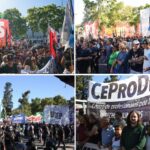
A recent report carried out on Argentine Social Debt Observatory of the Argentine Catholic University (ODSA-UCA), maintains that the level of Poverty rose to 55% and destitution to 18% of the population in the first quarter of the year.
In statements to radio Rivadavia, Augustine Salvia He highlighted the jump in destitution – which doubled in one year – that “it is the result of inflation and the deterioration of informal jobs.” And he pointed out underlying factors “this is related to the fact that 50% of employment is informal.” , something that accumulated over 20 years at the hands of a regime that did not promote investments and genuine employment.”
The rapid increase in the level of poverty and indigence responds to the consequences of the fiscal adjustment plan promoted by Milei. Also to the measures that raised the prices of goods and services, while salaries remained far behind those increases. The rising cost of living, and the consequent loss of purchasing power of income, explain these alarming data.
Structural poverty
According to the latest official data from Indec, if only the fourth quarter of 2023 is taken, the rate rises to 44.9%. Thus, towards the end of last year there were 20 million poor people, and of that total, about 5.5 million indigent. It is worth clarifying that Indec’s measurement method is based on income access to a minimum consumption basket, which does not include, for example, key expenses such as rent.

For Salvia, the increase in poverty “would have reached its ceiling and we would have experienced the worst, based on a partial recovery of income.” Even so, the poverty specialist warned that “for a long time, in Argentina there has been a segment of chronic, structural poverty, which is not measured by income but by education, health, housing, urban services.” And he stressed that “Even if inflation goes down, we will continue with chronic poverty because a good part of the jobs are of very low quality.”
In a recent special report carried out by La Izquierda Diario, the economist Agustín Arakaki pointed out that structural poverty refers to the idea of persistence over time, that is, of a population that cannot escape the situation of poverty. But he explains that it is difficult to capture it because there is no source of information that allows this monitoring. “A second condition must be added, which is that these people do not manage to escape poverty in a “positive context”, which, at a minimum, requires that the economy grow,” says Arakaki.
In relation to the course of brutal adjustment of the economy, he maintained that “The measures adopted so far by the government do not suggest that they are thinking about growth that favors workers, retirees and beneficiaries of social programs.”
Other official data show a recessive context with collapse in industry, in construction. The decline in the purchasing power of salaries has had an impact on a sharp drop in sales, and consequently the first announcements of layoffs due to the economic contraction are being seen. Despite the relative low in inflation in April, the weight of services, rentals, and prepaid payments in income is increasing. There is a lot of month left over at the end of the salary.
The president has decided to follow to the letter the IMF’s demands to comply with the payment of an odious debt. Fiscal austerity, cuts in social spending, layoffs in public employment and elimination of economic subsidies for energy, are just some examples. Starting in 2025-2026, a payment schedule so demanding that it is totally contrary to any improvement in the social situation will begin to govern. In some years, maturities will total around $20 billion. In this way, any prospect of exit must imply a profound rethinking of the current coordinates of the economy and a break with the IMF.
Source: www.laizquierdadiario.com

